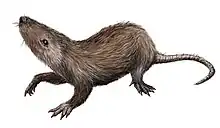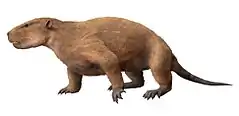Liotomus
Liotomus is a genus of extinct mammal from the Paleocene epoch (early Cenozoic era). It lived in Europe and North America, and was a member of the extinct order Multituberculata, lying within the suborder Cimolodonta and possibly the family Cimolodontidae.
| Liotomus Temporal range: | |
|---|---|
| Scientific classification | |
| Domain: | Eukaryota |
| Kingdom: | Animalia |
| Phylum: | Chordata |
| Class: | Mammalia |
| Order: | †Multituberculata |
| Family: | †Cimolodontidae |
| Genus: | †Liotomus Cope, 1884 |
| Species | |
| |
The genus Liotomus was named by E. D. Cope in 1884. This genus is sometimes placed within family Eucosmodontidae (Jepsen 1940).
Species
- Liotomus marshi (Lemoine, 1882)
- Liotomus vanvaleni
- L. vanvaleni remains are known from the San Juan Basin, New Mexico.
References
- Cope (1884), "The Tertiary Marsupialia." American Naturalist, 18, p. 686-697.
- Sloan (1981), "Systematics of Paleocene multituberculates from the San Juan Basin, New Mexico," pp. 127–160, in Lucas et al. (eds), "Advances in San Juan Basin paleontology." University of New Mexico Press, Albuquerque.
- Kielan-Jaworowska Z & Hurum JH (2001), "Phylogeny and Systematics of multituberculate mammals." Paleontology 44, p. 389-429.
This article is issued from Wikipedia. The text is licensed under Creative Commons - Attribution - Sharealike. Additional terms may apply for the media files.

